Every now and then you need to service your vehicle and that means needing to lift it a couple of inches. That’s what will ultimately make the difference between a comfortable servicing session and an uncomfortable one. That said, you’ve got lots of options when it comes to ramps, whatever vehicle they are for. There are the low profile ones and the heavy duty ones and everything in between.
Depending on the kind of vehicle you’re looking to ramp up, you need to get the right ramp. That means one that supports the weight of your car. If you fail to do this you’re going to end up stressing your ramp a lot and risk it bending.
It’s not even just about getting the right ramp. Ultimately, whatever ramp you have, it is still a much cheaper option than the post garage car lifts on the market, both 2 and 4 lift. Sure, you might miss a bit of extra lift if you choose a ramp over a post garage car lift, but you will get enough space and you’ll be able to do what you want with your car. Most mechanics have a soft spot for ramps anyway and would choose a ramp any day over a trolley jack for no other reason than the fact that a ramp is much safer. With a car trolley jack, all it takes is one slip and there you are, stuck underneath your car in one of the most uncomfortable, and dangerous, positions you can ever be. Ramps also come with much more security because they have wheel chocks that make sure the car doesn’t get the opportunity to roll back once it’s been placed on the ramp.
- Features to Consider in Good Loading Ramps
- Top 10 Best Loading Ramps 2026
- 1. Aluminum Trailer Car Ramp Car ATV Truck Ramps
- 2. LBS Aluminum Car Trucks Ramps Trailer Auto Hauler Hooks Ends Half Knife
- 3. Highland 69 Inch 1120500 Aluminum Straight Loading Ramp – Pair
- 4. Aluminum Ramps Truck Trailer Car Ramps 8000 pounds Capacity
- 5. Yutrax TX107 Folding Arch Ramps
- 6. Titan Wide 10 HD Aluminum Truck Load Ramp
- 7. Apex S-368-1500 Aluminum Shed Ramp
- 8. Highland 1127200 Smooth Rung Tri-Fold Loading Ramp
- 9. Pit Posse Motorcycle Folding Loading Ramp
- 10. TurboSmart Kompact
- Guide to Buying the Best Loading Ramps
- Final Words
Features to Consider in Good Loading Ramps
So you’re thinking of getting a ramp but have no idea where to start. How do you make the right choice? There are essential features to look for that all good ramps have in common, especially when you’re on a budget and need the bare bones instead of all the bells and whistles that come with the most expensive ramps.
With a good ramp, something as simple as draining your oil will be much easier than if you don’t have one. The same goes for the more complicated tasks that need you or your mechanic to be under your vehicle for an extended period of time. That said, it’s understandable that choosing the right kind of loading ramp can be a hectic process with all the options out there. Here are some of the things you should put to mind when you’re choosing a ramp.
The Capacity of the Ramp
The first and most important thing you need to have at your fingertips is the capacity of your car, truck, motorcycle, or ATV. This is information you should have long before you set out to purchase your first ramp. You simply don’t just go out there and get a ramp that can handle any weight. The idea that a ramp can handle any weight is misleading and will lead you to buying some pretty lightweight ramps that get stressed under the weight of your car and become very useless very quickly. What you need to do is get a ramp that can handle a weight greater than that of your car to be on the safer side. That way you know it will be able to handle your car, and then some.
You need to check your budget to see how much weight capacity you can purchase in a ramp. The limit out there really is the one in your pocket. Ramps come in all kinds from the very high capacity ones to the very low capacity ones and getting the right one means finding the best option within your budget.
For most vehicles, including trucks and regular cars, a ramp that is capable of handling between 6500 pounds and 10,000 pounds should do just fine and such a ramp will typically cost you anywhere between $25 and $250.
The Size of the Ramp
Yes, size matters, especially with ramps. The first thing you notice is that the tailgates of many pickup trucks are higher than the tailgates of many trailers. That is a crucial fact to consider. Think about it; when you’re trying to load, the angler steeper height is less than the loading height. This presents something of a dilemma.
Since loading ramps are built to work with steeper angles, the onus is on you to choose a loading ramp that is long enough to be safe and make the loading angle as small as possible for you. That is where the size of the ramp comes in.
You will need to consider a couple of things to find the right loading ramp in this case. The very first is the width of the loading ramp. This matters a great deal when you’re trying to figure out what model to buy. If you go for a single version, then the width pretty much has to be equal to the width of your car or truck. If you go for a dual set up on the other hand, then each individual ramp has to have a width as wide apart as the width of the tire. That’s the ideal width for loading ramps with dual set ups.
A wider ramp is much better for you, both when it comes to safety and when it comes to efficiency. You will find yourself being much quicker and, most importantly, much safer, with a loading ramp of the right width as you load and unload your vehicle.
The Design of the Ramp
Here is something else you simply cannot skimp on. When it comes to the design of the ramp, you’ve got two choices, each with its own set of pros and cons. You could go for a ramp with a single runner set up or you could go for a ramp with a dual runner set up.
A single runner ramp can accommodate your entire vehicle, no worries there. They are also usually possible to fold and unfold, making them highly portable. Some of them will even allow you to fold up to 3 times. That’s something you can easily turn into a compact load for transportation, meaning you can carry your ramp with you to the ends of the earth and never have to worry about lifting your car again, no matter where you are. That said, the single runners have their issues. To begin with, single running ramps are much heavier than their dual running counterparts. Single runners are very sturdy, but that sturdiness comes at the price of weight. You can feel the impact when you’re carrying one in the trunk of your car or truck; it will weigh the car down. Additionally, handling it, even when folding it, can give you a headache.
Dual runners come with two individual ramps that are typically as wide as the tires of the car you want to load. They can easily be adjusted so the distance between them is either narrowed or widened. That’s a massive advantage because it means that your dual running ramp can handle both small and large vehicles within its weight limit. In fact, the ramps with the highest capacities when it comes to weight are almost always dual runners.
When it comes to clearance, whether you’re getting a single runner or a dual runner, an arched runner is your best bet. These ramps are arched to prevent dangerous pumps when loading and unloading your car or truck, making them much safer.
Locally made Ramps
You should also consider the provenance of the ramp that you are buying. In this case, you should seriously consider buying ramps that were made in the USA. There are lots of imported models from Europe and China.
Admittedly, some of these models are much more reliable than the local ones. However, not all of them are reliable and the quality can differ wildly depending on the model you buy and the country of manufacture. That’s too much uncertainty to deal with. When it comes to raps made locally in the USA, you will be dealing with high quality all round.
Remember that your greatest priority when dealing with a ramp is your safety. You will, after all, be in your car, which means you need to be safe. When you go for a ramp made in the USA, you will be going for a ramp that went through the most thorough manufacturing processes and stringent inspections. Additionally, you will be supporting thousands of jobs locally and will be doing your patriotic duty to your country.
Despite all that, if you still feel like it doesn’t really matter to you whether the ramp you buy was made locally or imported, you should always consider getting one from Europe, Taiwan, or China. Ramps from other countries tend to be of lower quality overall.
Other Things to consider
It doesn’t end there. When you’re picking a ramp, there are lots of other accessories and extra features that you will find with most of them. You can get ramps for small motor vehicles. These ramps will hold just about any small vehicle you want to load on them so long as you are within the weight limit. On the other end of the spectrum you will find ramps that are specifically designed for snowmobiles. These will make it possible for you to survive through those tough winters when you’re not getting enough traction on a regular ramp.
You will also get ramps whose tips have been rubberized, or have hooks, or safety straps, or all of these combined. All of these are additional safety measures that ensure you have firmly secured your ramp to the vehicle to avoid serious damage to your vehicle or personal injury to any person involved in the loading process. They are especially important when you’re using your ramp on a surface that’s not level. Use a regular ramp with an irregular surface and the set up could get very destabilized very quickly.
As is common for most people who go shopping for loading ramps, you’re likely a do it yourself kind of person. In that case, you might not need to buy a ramp. Why not build your own? There are lots of ramp kits on the market that allow you to build your own ramp. You start with two short ramps made out of metal. These are what you attach to the tail gate on your pickup. Two wooden boards will then be attached to these two short metal ramps. You will then bolt them together and they you have it, a much more affordable solution!
Top 10 Best Loading Ramps 2026
1. Aluminum Trailer Car Ramp Car ATV Truck Ramps
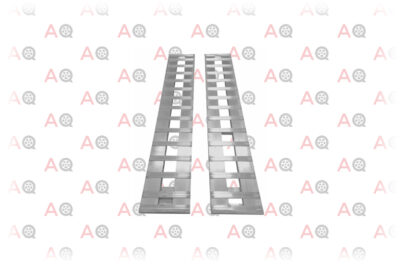
Editor’s Rating:
Design and Performance
This is just about the most cost effective, simple, and reliable loading ramp out there. The only downside is that it doesn’t fold so you have to figure out the storage.
The runners are wider than most others and the rungs have much better traction and are thicker. They can hold 625 pounds per rung, making them perfect for ATVs and other small vehicles and weigh around twenty pounds.
Pros
- Durable
- One year warranty
- Adjustable safety straps
- Can handle threads of up to 13 inches
Cons
- Doesn’t fold
2. LBS Aluminum Car Trucks Ramps Trailer Auto Hauler Hooks Ends Half Knife

Editor’s Rating:
Design and Performance
Each run of this dual runner weighs 31 pounds and will hold 6800 pounds per axle. That brings the maximum load to 13600 pounds, which means this ramp will comfortable hold just about any vehicle, even tractors! The maximum load height is also pretty generous at 36 inches.
The top end on this ramp is also very durable and will not bend with time, even when hooked at 36 inches or higher. It is manufactured in Ohio, USA, and comes with a one year warranty. You even get a full refund (minus $100 for shipping and handling) if you return it within the first 30 days.
Pros
- Big enough for any vehicle
- Comes with a one year warranty
- Made in the USA
Cons
- Expensive
3. Highland 69 Inch 1120500 Aluminum Straight Loading Ramp – Pair
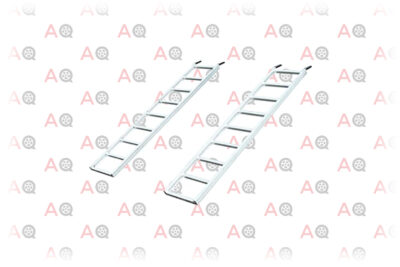
Editor’s Rating:
Design and Performance
This loading ramp is made of aluminum, as would be expected of any high quality ramp, and is pretty durable when compared to its price tag. It comes with straps to secure it firmly and ensure safety during the loading process. It measures 69 inches by 13 inches and has a capacity of 1250 pounds. This ramp is perfect for those on a budget.
Pros
- Resistant to rust and corrosion
- Has a one year warranty
- Comes with adjustable straps
- Affordable
Cons
- The top isn’t well bent enough to hold large weights
4. Aluminum Ramps Truck Trailer Car Ramps 8000 pounds Capacity

Editor’s Rating:
Design and Performance
These ramps are excellent for loading and unloading pretty much any kind of vehicle on and off a trailer, with heavy duty construction and very high weight capacity. They are made of aluminum, making for light weight and have a low profile design to allow for easy storage and transportation. This ramp can work on just about any kind of trailer and comes with a one year warranty.
The surface consists of serrated cross bars for traction and the hook end gives a sturdy grip and is coupled with round rails or rub rails. Some of them even have pin-on ends.
Pros
- It has a strong grip due to the combination of the hook end and the rub or round rails
- Can be used on any type of trailer and can carry any kind of wheeled vehicle
- Is highly portable and lightweight
Cons
- Could do with bolting as well, in addition to the hook end for extra firmness
5. Yutrax TX107 Folding Arch Ramps
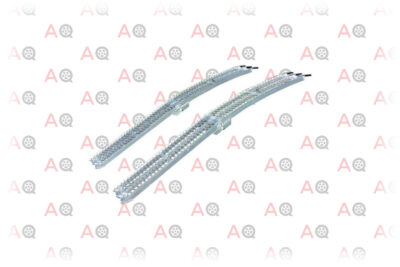
Editor’s Rating:
Design and Performance
This very special arched ramp is engineered for nothing but strength and versatility. It has a 1500 loading capacity and is 89 inches long with a folded weight of only 32 pounds.
It is made from rust-resistant, light, and strong aluminum and is highly portable. The arched design makes for less bounce and it gives very good traction and clearance for smaller vehicles such as golf carts, which do not have 4 wheel drive transmission. It can be a little difficult for such small vehicles to climb up cross bars and so the mesh in this ramp provides good traction.
Pros
- Excellent traction
- Great construction
- The extruding side rails do not bend
- The taller rectangular cross section supports more weight
Cons
- It looks a little unattractive
- It has a basic design and is only good for use with smaller vehicles
6. Titan Wide 10 HD Aluminum Truck Load Ramp
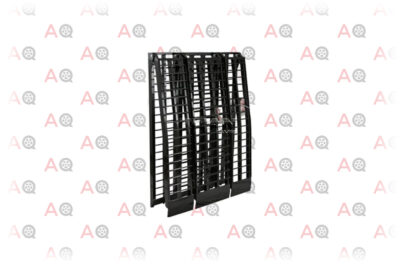
Editor’s Rating:
Design and Performance
This loading ramp is perfect for those with motorcycles. The rungs are 5/8” thick and will offer excellent support for the loading of heavy items. The side-loading is also perfect the loading of 4-wheel items.
This ramp has a total capacity of 2700 pounds in distributed weight and features an arched design to make for excellent clearance. The middle ramp has a thicker 4-beam design than the side ramps and it comes fully assembled. It has safety straps for firm holding and serrated crossbars for extra traction.
Pros
- Fully assembles
- Arched design
- Has serrated bars for extra traction
Cons
- Bolting holds it down more firmly than strapping as the ratchet straps aren’t the best.
7. Apex S-368-1500 Aluminum Shed Ramp
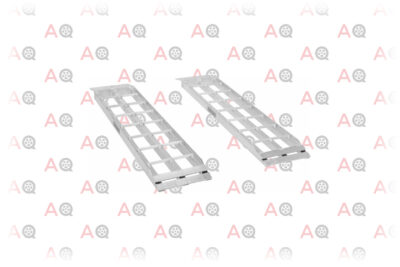
Editor’s Rating:
Design and Performance
This is a fantastic shed ramp from Apex that is constructed from aluminum to be able to withstand stress and inclement weather conditions. It has a 3.5 inch rung spacing which makes it perfect for loading lawn mowers, generators, and other small wheeled equipment into elevated areas. It is a dual ramp, meaning it has two runners and each ramp is capable of holding up to 750 pounds, giving the combined dual ramp a capacity of 1500 pounds. It measures 36 inches by 18 inches, making it highly portable.
Pros
- It only weighs 4 pounds, which makes carrying it around very easy
- It is perfect for use around the home
- The attaching lip makes it easy to attach permanently to a storage shed
Cons
- It is only meant for small wheeled equipment due to its low weight capacity
8. Highland 1127200 Smooth Rung Tri-Fold Loading Ramp
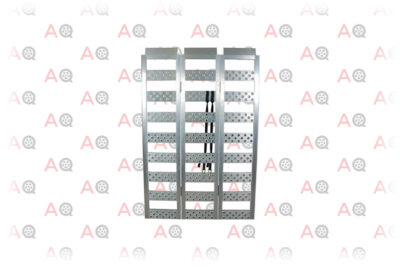
Editor’s Rating:
Design and Performance
This smooth rung tri-folding loading ramp from Highland is made of the ever durable, strong, and lightweight metal aluminum. It has the ability to withstand extreme weather conditions and will not corrode or rust. It also has 360 degree non-slip ribs that give it just the right amount of traction to make for an easy loading process. It can hold up to 1600 pounds and measures 69 inches by 45 inches.
Pros
- It comes with a warranty of one year
- It has very close rung spacing which means it will accommodate wheels of just about any size.
- It has strong adjustable straps that will firmly hold it in place during the loading process.
Cons
- It has a small weight capacity and is for small wheeled equipment
9. Pit Posse Motorcycle Folding Loading Ramp

Editor’s Rating:
Design and Performance
This motorcycle folding ramp is constructed from aluminum for its sturdiness, lightweight construction, and resistance to extreme weather conditions. The ramp can easily withstand conditions that would lead to easy and quick wear and tear in other ramps and will resist both corrosion and rusting. Since it’s foldable, it is highly portable and small, measuring 89 inches by 11 inches.
Pros
- It comes with a 5-year warranty
- It has a rubber grip that protects your truck from nasty scratches
- It has a tie-down strap to hold it in place during the loading process
Cons
- It is only meant for motorcycles.
10. TurboSmart Kompact
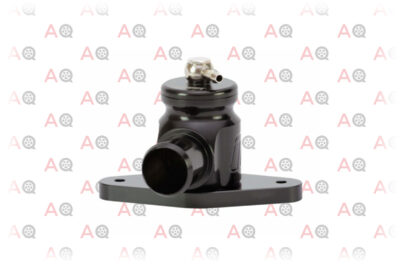
Editor’s Rating:
Design and Performance
This blow off valve is a direct bolt-on replacement for the valve that comes from the factory for most EcoBoost, EFR, and BorgWarner turbos. As a result, it’s pretty much a good fit for most engines. It has almost instantaneous pressure response that’s probably only matched in speed by electricity. Additionally, it is housed in solid billet aluminum and has a small body that makes for very easy installation.
The kit comes with everything you’ll need for installation and doesn’t require much moving and removing of parts and hoses in your engine to fit the blow off valve. In terms of performance, it has a dual port construction that offers some of the best responsive flow characteristics on the market, thereby maximizing the sound output and pushing the air. Speaking of sound, it produces the most beautiful sound on this list. That’s why it got the highest rating.
Hear the beautiful sound here
Pros
- Small size
- Easy installation
- Excellent performance
- Beautiful sound
Cons
- No major cons
Guide to Buying the Best Loading Ramps
Why should you pick the Right Ramp Size?
We’ve been talking about and emphasizing the size of the ramp a lot in this article, so why does it matter so much? Well, the right size ensures that two things happen when you’re operating the ramp: the first is a smooth operation and the second is your safety. Both of these are important and save you time, effort, and money (on medical and repair bills).
You need to make sure that the ramp is capable of holding your weight as well as that of the vehicle and whatever cargo the vehicle might be handling. That’s why it’s so important to get a ramp whose weight limit is above that of your vehicle.
It doesn’t just end at the weight, however. There is also the length and the width of the ramp to consider. With the length, you need a longer ramp to handle a heavy vehicle. This is because longer ramps also tend to be heavier and so are capable of handling heavier vehicles. The length also matters when determining the clearance that is required by the vehicle. If you need higher clearance then you need a longer ramp. Alternatively, you can get an arched ramp, which makes for higher clearances and also prevents the vehicle from pumping.
When it comes to width, a wide ramp, especially when you’re dealing with a single running ramp, means that you can load a larger vehicle. When you’re dealing with dual running ramps, then the individual runners need to be as wide as the tires on the largest vehicle you will load on that ramp. Luckily, you can adjust the distance between the runners on dual running ramps so you don’t have to worry about the overall width of such ramps. That said, you should always check that the individual runners are wide enough to hold the tires of the vehicle that you would like to load on to the ramp.
The Case for Low Profile Ramps
Your vehicle has a low profile or absolutely no ground clearance. In such a situation, you go for a low profile ramp. These ramps have much longer inclines and are gradual in their ascent, making it possible for you to load low profile vehicles such as sports cars. With such vehicles, the trick to prevent the vehicle from touching the undercarriage and getting damaged. Be careful, however; do not get a low profile ramp for a vehicle with high clearance as it will make for a very inefficient operation.
The Proper Use of Ramps
When you compare a loading ramp to a steel jack, you immediately notice how much better a loading ramp is, primarily because of how much easier it is to use. That ease of use, however, only comes when you know how to correctly use the loading ramp in a manner that is both safe and correct.
You will need to do some practice, especially with driving up and down a ramp. However, you don’t have to worry about much. As long as you have placed your ramp on an even and smooth surface, you can be sure your car is going to do just fine. That said, here are some steps you can take to make sure you’re using your car ramp the way it was meant to be used.
Park at the Starting Point
Where you park your car before you load it is just as important as all the features of the loading ramp combined. If you don’t park at the right spot, then it doesn’t matter if you have the best loading ramp in the world. Not only will the loading process be difficult and uncomfortable, but it will also be very unsafe for you and your vehicle.
Make sure that the surface on which you have parked your car is smooth, level, and sturdy so it can hold up the weight of your car. The surface should also not be slippery because your vehicle will need plenty of traction to go up the loading ramp. The wheels of your car should also be facing directly forward so make sure the power steering wheel is positioned correctly.
Position the Ramps
This needs to be correct, whether you’re dealing with a single running ramp or a dual running one. Take the ramp and position it with the lower slope facing in your direction. Adjust it as much as you need to make sure that it is flush with your front tires. This is a crucial step because the last thing you want is for the tire to be unevenly placed on the ramp because the car might fall off. That said, it is even more important that the ramp is flush with the tires when you’re dealing with dual running ramps than single running ones. Single running ramps have a greater margin of error than dual running ramps due to the fact that dual runners need to carry a single pair of front and rear tires per runner.
To make sure you get it right, verify that the ramp and your tires are flush by looking along the side of your car or truck. You will be able to tell that they are flush when they align from the side view. Do this for both sides of the car or both front wheels, if you will. As long as the front wheels are facing directly forward and they are aligned to the ramp, the back wheels will automatically follow suit.
Drive onto the Ramp’s Center
Now it’s time for the exciting part: sitting in your car and driving it onto the ramp. You will have to drive it forwards and upwards and do it very carefully. Once you’re onto the ramp, come out and check the wheels of your truck. Make sure they are on the flat area right on the center of the ramps.
While driving your car up the ramp, the last thing you want is for your wheels to be unevenly placed on the edge of the ramp. If you aligned your tires perfectly with the ramp, then this isn’t something you have to worry about. However, if you didn’t do it well, there is a chance your wheels will be teetering on the edge, threatening to fall off the ramp and lead your car to a resounding bounce on the ground. That’s why it’s important to check, just to be sure. If the wheels aren’t in the center of the ramp, or on the flat part of the ramp, then you will need to reverse your car to get it off the ramp and try to align the wheels with the ramp again. Keep doing this until you get it right. Again, it’s a matter of practice, but after a while you will be able to do it easily on the first try.
Use the Parking Brakes
So you’ve got the tires aligned, you’ve managed to drive your vehicle onto the flat area of the center of the ramp, and your tires aren’t threatening to fall off. Now what? Now, you have to secure your vehicle.
There are ramps out there that will offer you features or accessories to secure your vehicle, but the easiest and most inexpensive way to do that is from within the vehicle, with the parking brakes. The tires on your vehicle already have enough traction to ensure the vehicle won’t roll back under the force of gravity, so simply engaging them keeps your vehicle firmly in place. Any other security will merely be a bonus. That said, you still need to make sure your vehicle is firmly secure once you engage the parking brakes. To do that, come out of your vehicle and gently rock it to see how firm it is. If it holds its place, then you’re good to go for the next step.
Place the Wheel Chock
So you’ve engaged the parking brakes and the vehicle is secure. Is there a need for an extra measure of security? The answer is yes. Even with the parking brakes on, the tires on your car or truck could still slip and cause the vehicle to slide off the loading ramp. This is especially true in winter, when slippery surfaces are the norm. Probably why some people who live in cold areas prefer to use snow mobile loading ramps for their vehicles for the extra traction offered. For the rest of the loading ramps out there, there is the wheel chock.
Place one wheel chock in the back of the rear tires and another one in the front. Since the parking brake holds the front wheels firmly, the back wheels are the ones that need to be secured to make sure there isn’t going to be motion anywhere. Now your car or truck won’t roll of in any direction.
Once you’re done with these steps, your truck is firm and secure and you can get under it to begin your work.
Safety First
Ramps are a boon for loading just about anything from regular cars to trucks to trailers to elevated shed platforms. However, the key is to use them well and set them up properly. Otherwise you will end up dealing with some pretty dangerous and costly accidents. You might end up damaging your vehicle or causing injury to yourself and others. Some safety tips are in order so that your experience with a loading ramp is always a positive one.
Always wear Safety Gear
This one is easy to forget but it is still highly important and should be observed at all times. Whenever you’re loading your car or truck onto a loading ramp, you should remember to wear a helmet for the duration that you will be working under the car or truck.
When it comes to helmets, a whole article could be written about the best helmets to get and at what price. However, since we’re talking about loading ramps here, not much can be said other than to make sure you get a high quality helmet as will protect your head. Getting a high quality helmet could ultimately be the difference between getting the kind of injury that requires an urgent trip to the hospital and one that merely needs some ice and will be okay in a matter of days at most.
Other gear you should consider wearing are arm pads and knee pads, which protect the important hard joints in your body. As for when you’re driving the vehicle up the ramp, always remember to put on gloves.
Ensure there is Stability and Security for both the Vehicle and the Ramp
Before you even begin the process of loading your vehicle onto the ramp, make sure that the ramp itself is highly stable and secure. Do everything you need to do, such as checking the finger and lips to determine if they are sitting well on the bed of the truck or fastening the straps, but make sure it is stable before it has a vehicle’s weight bearing down on it.
If there are hinges on your ramp, then the latches should be tightly locked. The surface you use for the operation should also be level. Try to avoid parking on slopes because it makes for steeper angles and a more complicated operation. If you really want to minimize the angle on your ramp, then go for downhill parking. The ramp should be tightly secured before you load the vehicle and the straps and other protective measures should be secures on the bed of the truck after loading. That way, the ramp doesn’t fall off while you’re transporting it.
Slow but Sure Wins
Remember that the tires need to be aligned with the ramp before you begin the climb. While you actually make the climb, use the lowest gear and keep your movement smooth. Never ever, under any circumstances, change gears while you’re making the climb up a ramp. Also, if you’re planning to use the 4×4 transmission while working on the vehicle, make sure it is already engaged before you load the vehicle. Don’t speed the truck up the ramp and don’t abuse either the throttle or the brakes during the operation.
The ramp, the surroundings, and the truck bed should be clearly visible. If anything goes wrong, jump out of the truck and let it fall. Do not risk injury to yourself by staying inside. If you’re not confident doing it yourself, ask an experienced person to do the loading for you.
Final Words
Don’t be scared by the cost of a ramp. A high quality ramp, no matter what the cost, will never let you down. With the ramps and tips above, using a loading ramp should soon become second nature to you.


